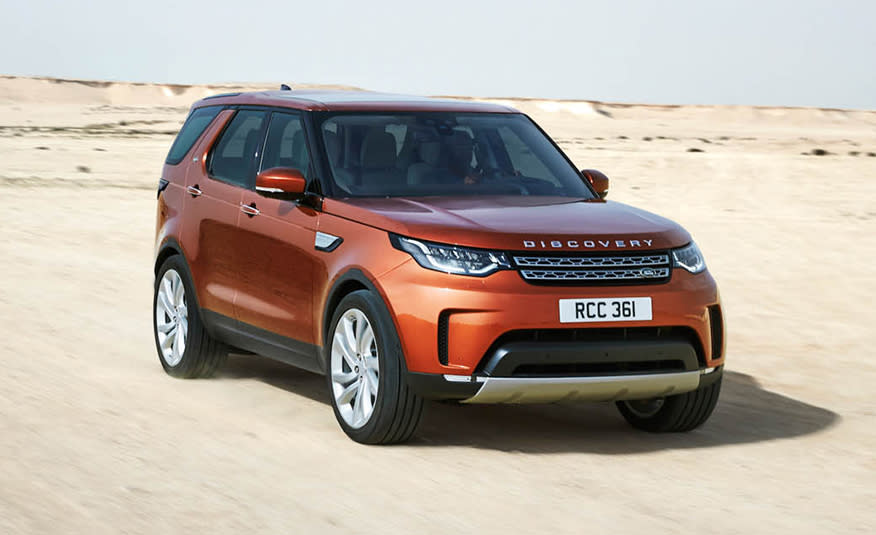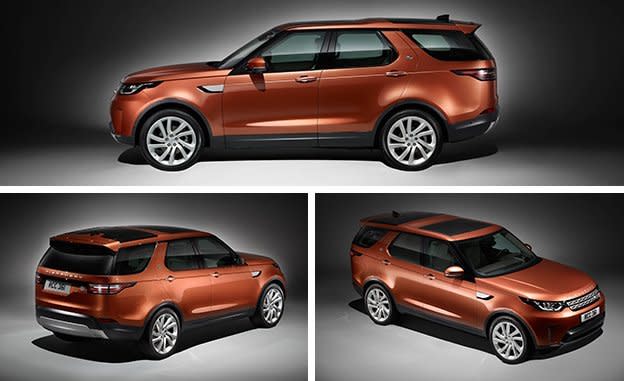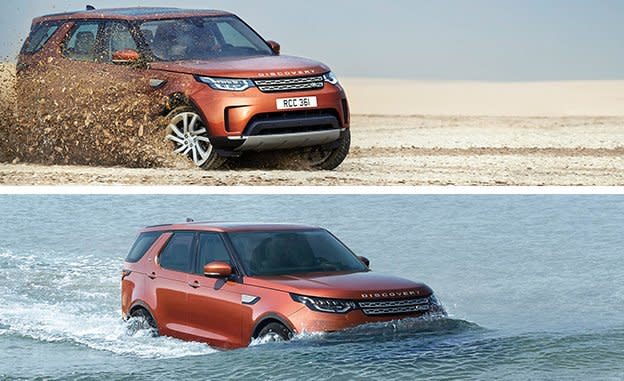2017 Land Rover Discovery: Newly Re-Discoveried

Although it sold a smattering of its classic Defender model here over the years, the vehicle that really launched the Land Rover brand—as distinct from Range Rover—in the United States was the Discovery, in the 1990s. While both the Discovery and the updated Discovery II quickly established themselves as the family SUVs most likely to complete an African safari, they earned an equally robust reputation as the SUVs most likely to suffer a catastrophic mechanical and/or electrical breakdown. So when a completely redesigned version launched in 2004, Land Rover stripped the “Discovery” badges off the U.S.–bound model, selling it instead as the LR3; it spawned the revised LR4 five years later. With that vehicle now trundling toward the sunset, Land Rover is reverting to the “Discovery” name for its successor, which arrives in mid-2017.
Outside of the retro nameplate, Land Rover is looking forward with the new vehicle, which was previewed by the Land Rover Discovery Vision concept seen at the New York auto show in 2014. With a new Defender in the works to handle extreme off-road needs, the Discovery was free to become “more premium and less rugged”—and yet ground clearance (11.1 inches) and wading depth (35.4 inches) have both increased over the LR4. Still, Land Rover chief design officer Gerry McGovern asserts: “We are strategically making Discovery closer to Range Rover.”

Discovery, Discovery Sport
Style-wise, however, the vehicle hews more closely to the pattern of the smaller Discovery Sport. The resemblance is evident in the shape of the C-pillar, the clamshell hood, the body-side groove that runs rearward from the front fender vents, and even the way DISCOVERY is spelled out on the leading edge of the hood and on the liftgate. The windshield is more steeply raked than the outgoing model’s, and the taillights go from vertical to horizontal. Gone are the LR4’s slab sides and the rear-quarter glass that extends into the roof. Vestiges of the LR4 can be seen only in the faintly stepped roofline and in the asymmetrical housing for the rear license plate. McGovern characterizes the overall design as “radically different from the current [LR4],” and indeed the new Discovery looks far less boxy, with more tumblehome and a shape that tapers toward the rear. The net result is dramatically more aerodynamic, with the coefficient of drag said to go from 0.40 to 0.35.
Although your eye tells you the new Discovery is smaller than LR4, it's actually 5.5 inches longer on a wheelbase stretched 1.5 inches, yet the roof sits 1.6 inches lower. Wheel sizes range from 19 to 22 inches. An available Dynamic Design package features its own special wheels and bumpers; sees the grille, the mirror caps, and the hood letters all rendered in black; and comes with a black- or gray-painted roof. None of the photos released thus far shows the Discovery with a roof rack. There's a reason for that. While a rack will be available, the chief designer would prefer you didn’t order it: “I hate roof racks,” says McGovern. “But if people want them they can go ahead and buy one and ruin the design.”
Take Off Your Wellies
Going sans roof rack could be tough for Land Rover traditionalists, who might be further alarmed that another key LR4 feature, the two-piece, asymmetrically split tailgate, also has been jettisoned in favor of a single-piece liftgate. Project engineers claim the change improves quality and allows for a larger opening. In order to preserve some of the benefit of the drop-down tailgate—i.e., providing “a place to take off your muddy Wellies,” in the word of chief engineer Alex Heslop—there’s an inner panel hinged at the floor, and it drops down when the liftgate is opened. This optional inner tailgate can support 300 pounds. It's power-operated and drops down automatically if the liftgate is opened with the key-fob remote; use the outside handle instead, and it will remain upright (to corral loose cargo) but can be dropped via a button just inside the open hatch. Additional buttons alongside it can raise or lower the air suspension and fold the second- and (optional) third-row seatbacks.

For an even neater trick, owners can raise or lower either section of the 60/40-split second-row seats or the 50/50-split third row via a smartphone app or through the in-dash touchscreen. That 10.2-inch touchscreen eliminates most of the buttons on the center stack, but at least a volume knob is preserved. Below the screen one finds the brand’s familiar HVAC controls featuring three large knobs; the panel that houses them flips up to reveal a storage cubby behind, one of many stowage spaces scattered throughout the interior. The Discovery also boasts up to four LATCH child-seat anchors: two in the outer second-row seating positions and two in the optional rearmost seats. All three rows boast seat heaters, and there are as many as nine USB ports and six 12-volt outlets on board. JLR’s so-called Active Key wristband (offered also on the Jaguar F-Pace) can be had—it locks and unlocks the door, allowing the driver to leave the key fob in the vehicle.
The interior design conforms to Land Rover’s current aesthetic, with a two-piece dash horizontally bisected by a strip of trim (either aluminum or wood), fold-down armrests attached to the front seats, door panels topped by wide sills where the window switches are located, and Jaguar Land Rover’s dial gearshift. Unusually in these days of black-or-beige cabins, there are five different interior color choices.
Dropping More Than a Few
The Discovery rides on Land Rover’s aluminum-intensive Premium Lightweight Architecture (PLA) platform, which also underpins the Range Rover and Range Rover Sport. Like those vehicles, the Discovery has ditched its heavy ladder frame in favor of unibody construction, and Land Rover claims enormous weight savings of approximately 1000 pounds. (For reference, the last LR4 we tested crushed the scales to the tune of 5941 pounds.)
Tasked with lugging that weight is one of two 3.0-liter V-6 engines: a Ford-sourced, 254-hp turbocharged diesel (Td6) with 443 lb-ft of torque as found in today’s Range Rover Sport or a supercharged 340-hp gasoline mill with 332 lb-ft of torque carried over from the LR4. (In Europe, two four-cylinder diesels also will be available.) Both are paired with an eight-speed automatic. Full-time four-wheel drive is standard, naturally, with either a single-speed Torsen center differential (with a 42/58 front-to-rear default torque split) or an available two-speed transfer case (which apportions the torque equally front-to-rear). Like its Range Rover siblings, the new Discovery also offers Land Rover’s All-Terrain Progress Control—essentially a low-speed, off-road cruise control. Coil-spring suspensions are standard with air springs optional (standard on the top-spec model)—the latter automatically lower the Discovery by 1.6 inches when a door is opened. The vehicle can be further lowered by a maximum of 2.4 inches from its standard height, or raised by 2.95 inches for additional ground clearance.

Stated towing capacity is 8201 pounds, and the Discovery also boasts what Land Rover calls Advanced Tow Assist, which can automatically steer the car when backing up with a trailer. Pulling up on the Terrain Response dial activates this towing mode, in which the center screen shows the rear camera display; the driver then uses the Terrain Response dial to aim trajectory lines where he or she wants the trailer to go, and the system automatically steers the car.
Land Rover expects the new Discovery to square off against the Audi Q7, BMW X5, and Volvo XC90—against which it sees its own offering as “more capable”—as well as more off-road–oriented four-by-fours such as the Toyota Land Cruiser and the Jeep Grand Cherokee, compared to which it hopes customers will find the Land Rover to be “more sophisticated.” In the middle of next year, sales kick off with a spate of fully loaded First Edition models—available in black, silver, and orange. Beyond the First Edition, Americans will be invited to rediscover the big Land Rover in one of three trim levels: SE, HSE, and HSE Luxury.
Prices start at $50,985—which is a bit cheaper than the LR4—for the base SE with the gasoline V-6. The HSE V-6 is $57,945, while the diesel adds $2000 to the HSE tally. The HSE Luxury runs $64,945 with the gas engine or $66,945 with the Td6. Finally the First Edition—only 529 of which will be offered—rings in at $74,945 but comes with a full complement of options, special colors and trim, and the unquantifiable panache of declaring the owner to be an early adopter.


 Yahoo Autos
Yahoo Autos 